| 1 | Sydney’s most common python |
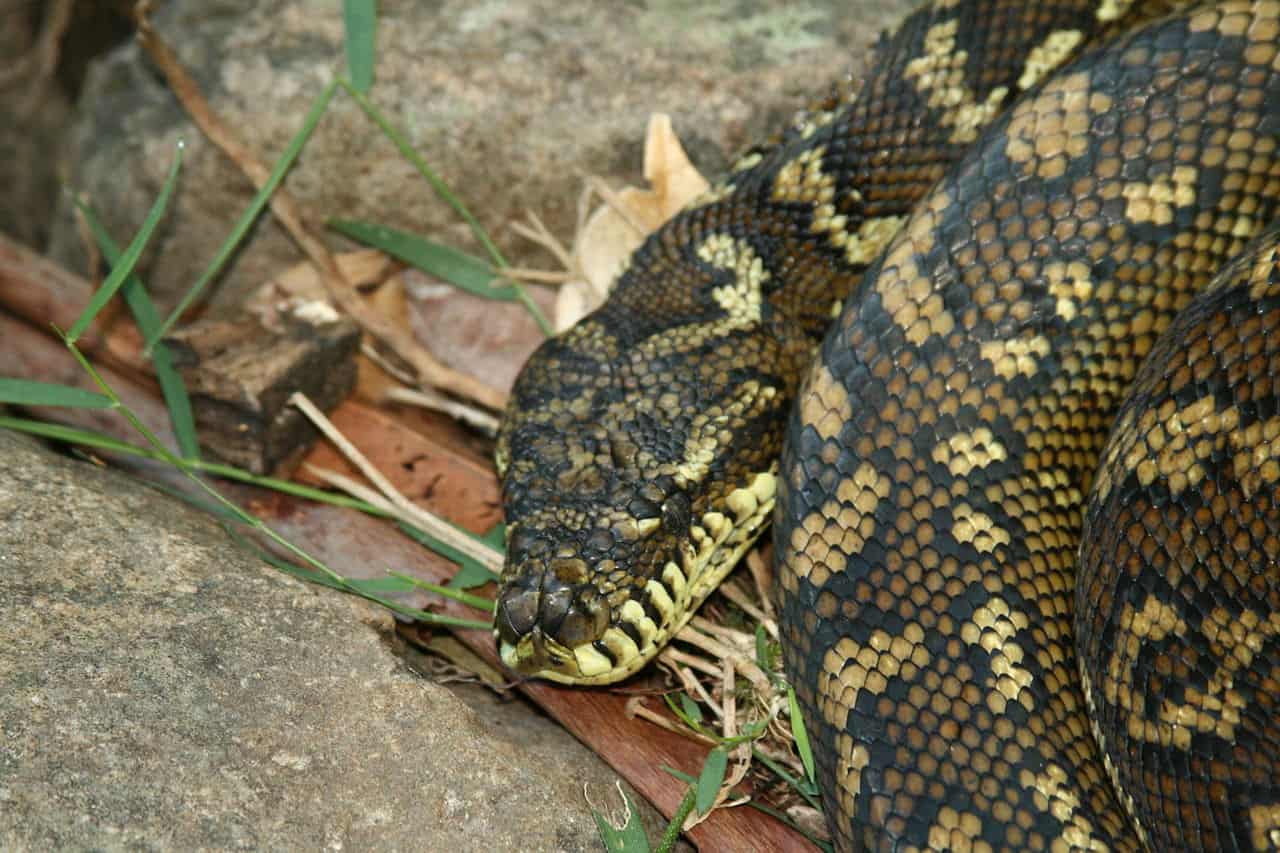
Australia has many python species, from the green python clinging to trees in Queensland, to the oenpelli python buried deep in outback cracks, which is so rare that it’s only spotted about once per decade. In eastern Australia, there’s a species which is far more common, and encountered pretty much every day by normal citizens – the carpet python (Morelia spilota).
This python is abundant in populous coastal areas such as Sydney and Brisbane. Of all Australian pythons, they’re easily the most commonly spotted around normal Australian residences, whether dangling from someone’s roof or lurking by the gates to a school.
Carpet pythons are a quiet species, and are sometimes so stealthy that homeowners have no clue that they live there. They’re a normal sight even in developed areas of Sydney, living side by side with the humans who mistakenly believe they control nature. They dislike agricultural land, as carpet pythons are most common in mixed habitats of bushes and tree clumps, rather than flat open land. Despite this, it’s believed that humanity has made carpet pythons more common, not less.
Like all pythons, this is a non-venomous ambush predator, which uses its powerful muscular body to constrict prey. The carpet python has one great claim to fame: being the most southerly python on Earth, with their absolute southernmost point lying in Mallacoota, Victoria.
| 2 | Not the longest, but still 3 metres |
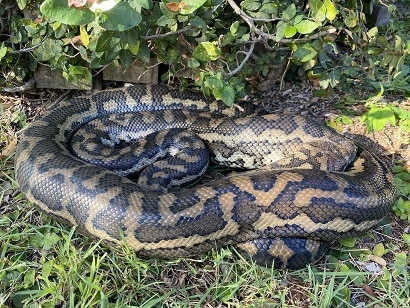
The carpet python is a long snake, though not as long as the scrub python or oenpelli python. 2 metres is the average, 2.5 metres is perfectly normal, and even 3 metres is so ordinary it’s not worth mentioning. There are wacky tales out there, including some spanning a double carriageway road, which haven’t been proven. But the longest on reliable record was 4.2 metres, and another caught at Pine Montan, Ipswich measured 3.9 metres.
This monster was another contender. It was a video that went viral on Tiktok in August 2023, showing a carpet python slithering slowly from a roof into a tree. The video was titled “5 metre carpet python”, and it’s tempting to dismiss this as excitable social media hype. Yet there’s no doubt that this carpet python was (and still is) truly enormous.
Carpet pythons also have the vestigial remnants of hind legs, which became useless when their ancient ancestors switched to slithering. They have a particularly variable colour, even within subspecies. Some are rich yellow contrasting against black, while others have the same patterns, but are far lighter. Their disguise is so perfect that they can become invisible in thickets, even outside a yard that you know like the back of your hand.
| 3 | U-shaped bites |
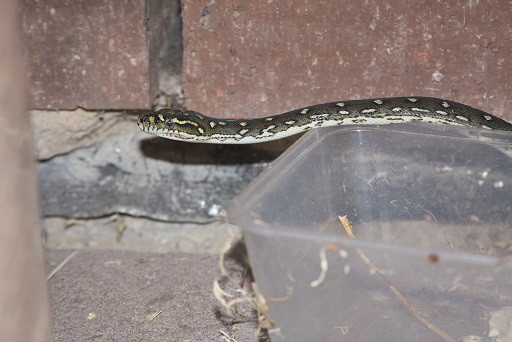
Like most of its family, carpet pythons are an ambush hunter. They wait patiently with their head resting on their coils, tiled approximately 15 degrees above horizontal. They cleverly position themselves on the edges of well-trodden trails used by rats, rabbits and bandicoots. They usually keep their body under cover, such as thickets, with their head pointing towards the open areas adjacent.
Carpet pythons have a distinctive bite shape: either a U-shape or two nearby U-shapes. After pouncing, the first contact with prey is with their teeth, which hook in, before they apply a jail of inescapable coils. After constriction is complete, they release their prey briefly before commencing swallowing, allowing them to go for the head first.
Like most pythons, Morelia spilota doesn’t move much; you could walk past a clump of bushes on your way to school and spot a carpet python just metres from where it was two weeks ago. Nevertheless, Morelia spilota isn’t as mind-numbingly lazy as some pythons or boas. A study monitored 19 carpet pythons using radio tracking, for a mean of 308 days. The pythons moved the most during spring, averaging at 12.3 metres per day. They moved 11.4 metres daily during summer, while winter was a glorious season of utter laziness, at just 1.4 metres moved per day.
| 4 | A confirmed koala killer |
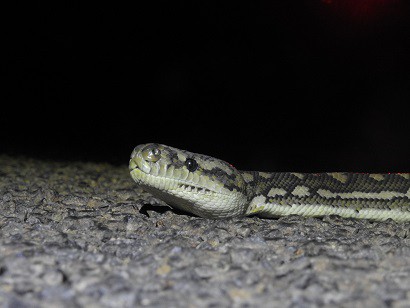
While preferring ambush, carpet pythons also search for prey actively, investigating sheds, tree trunks and root hollows. Birds are their second favourite prey after mammals, and they have a tendency to invade aviaries, gobble up the occupants, and lie around afterwards digesting them in peace, ignoring the humans standing back in shock.
Carpet pythons have a secret daily movement pattern, their most active period being from 8:00-10:00. From ten onwards, they become as immobile as a boulder, until 18:00 arrives and they suddenly rev up again. Carpet pythons feed most heavily during summer, eating 70% of their meals from December to February. They’re relatively slow eaters, taking 45 minutes to swallow a single rabbit.
Caret pythons seem to be the sworn enemy of cuteness. They’re confirmed to swallow pet cats, as they lurk outside households in disguising thickets. Much more disturbing is that they’re the koala bear’s second most common predator, behind the dingo. A study following 503 koalas found that carpet pythons contributed 11.6% of predator deaths, and 7.2% of total deaths. Worse is that many were found with their fur slicked back, covered in a sticky snake slime, with a pair of U-shaped bite marks, as though the snake had killed them, but not bothered to successfully swallow.
| 5 | Mainly eats mammals |
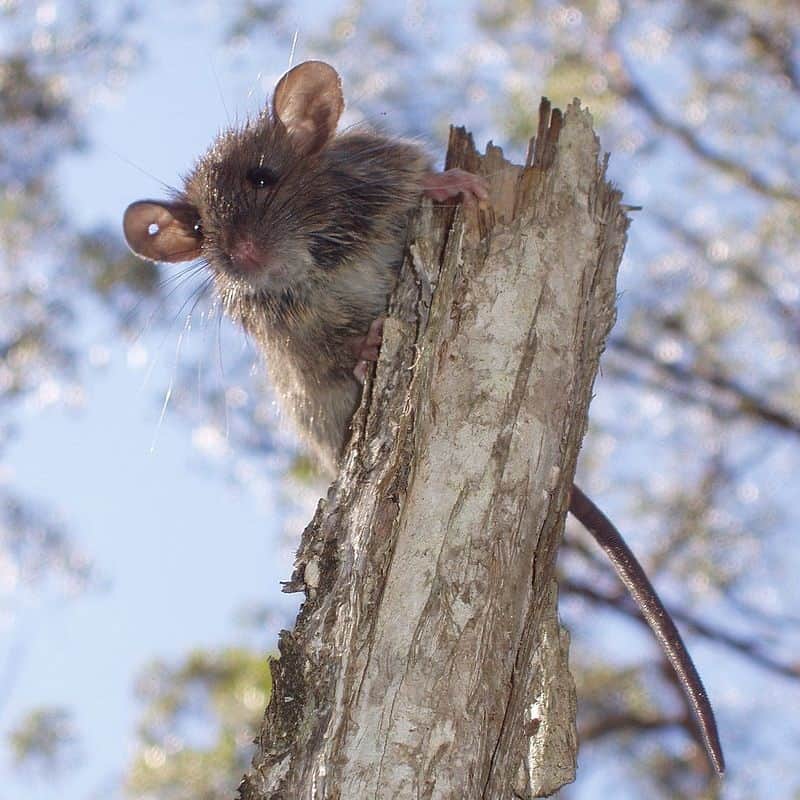
The food preferences of carpet pythons are often vague. “Birds, mammals and reptiles” are reported in fun, pocket-sized guides to Australian snakes. In 1988, however, a study analysed 108 carpet pythons of Australia’s southeast coast, AKA the diamond python subspecies (Morelia spilota spilota).
49 snakes had food items in their bellies. Several had two in their belly at once, while one carpet python had three. The overwhelming majority (86%) of the carpet python’s prey was mammals. The single most common prey was the Australian bush rat, while the introduced black rat was second. Opossums were also popular, particularly the large brushtail opossum, and rabbits popped up occasionally. In second place came birds at just 9% of prey, followed by reptiles at 5%.
Meanwhile, juvenile carpet pythons were tested in captivity, as they were impossible to find in the wild. They accepted rats, but had a ravenous hunger for copper-tailed skinks, flecking their tongues and gobbling them down. This snake transitions to mammals as it ages, like its Morelia relatives. The only Australian python that primarily eats reptiles is the black-headed python.
| 6 | Commonly found in roofs |
Compared to their fellow family member the green tree python (Morelia viridis), carpet pythons are more ground-dwelling, but they haven’t shaken off the influence completely. A radio-tracking study found that 45% of their time was spent in trees. They can even ambush in trees, as one was spotted eating a brushtail opossum in the fork of a eucalyptus tree, 6 metres above ground.
The same is true for reproduction, as either ground or branches is perfectly acceptable for mating. However, they’re so obsessed with covering themselves that even when in trees, they’re rarely visible from the ground below. Researchers have stood below with their radio-trackers beeping, looking up into branches, and not been able to pinpoint them.
The carpet python can reach heights of over 10 metres. This leads to another tendency: the carpet python loves to hide in people’s roofs. Anyone shooing off a bird’s nest could get a much nastier surprise in their face, although most carpet pythons are quite docile (except the jungle version). One female carpet python rested in the same dark roof for 92 days.
| 7 | Mothers coil around their eggs |
Mother carpet pythons abandon their young instantly after hatching, but coil around the eggs for several weeks, until they’ve successfully broken free. Keeping tight coils prevents the eggs from losing moisture to the air, absorbing into the mother snake instead.
Sometimes their plans go awry, as one carpet python was spotted laying eggs behind a pile of banana leaves and stems, 16 eggs in total. At first this was perfect shelter, but over 2 months, the foliage slowly rotted away until the mother python was badly exposed, visible to predators. Nevertheless, her close attention saw the eggs through. Mother carpet pythons will shiver as they coil around eggs to generate body heat.
One radio-tracked carpet python laid her eggs on a hillside, 80 metres from a creek. Another laid them 2 metres from a creek, and another laid 15 eggs beneath a pit of lumber in December 1996. Houses aren’t off limits, as on December 11th 1995, a carpet python was found in a cardboard box in an urban shed, coiled around 15 eggs. They’re very flexible, as long as there’s shelter. The number ranges from 9 to 54.
| 8 | Super-rapid growth |
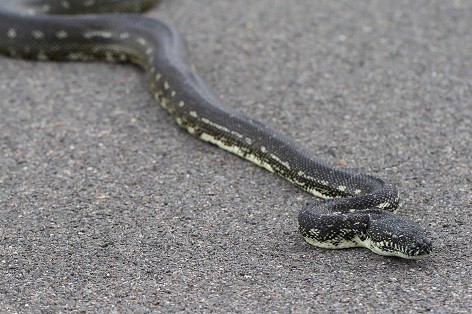
Some pythons can grow extremely rapidly. The amethyst python, for example, can reach 210cm in its second year. In 1995, Simon Fearn acquired a baby carpet python from a mother measuring 244cm. This was one of 21 eggs, and the newborn measured 58cm. After 12 months, it had rocketed in length, to 213cm. Carpet pythons are shorter than scrub pythons, but the longest can exceed 4 metres.
Carpet pythons are popular in captivity worldwide, as they’re more exciting than a ball python (100cm) and less likely to eat you than reticulated python (600-700cm). One of the most striking morphs is the jaguar, which was first bred in captivity in 1994. The male was born light pink, and by 1997, it had bloomed into striking yellow and black jaguar colours. In 1997, he bred it with an unrelated female. After waiting with baited breath, one of the 4 hatchlings also had the jaguar colours, proving that the phase was genetically inherited. The original male’s genes have now spread to hundreds of captive descendants. Unfortunately, this comes with a curse, as jaguar carpet pythons tend to have neurological problems like a swaying head.
| 9 | The three-eyed fluke |
Freaky deformities are relatively common in reptiles compared to mammals, but the carpet python had one of the freakiest: a three eyed baby (video). This was found in the Northern Territory, in the town of Humptee Doo not far from Darwin. The first two eyeballs were in their normal position but lower, whereas eyeball 3 was on the equivalent of its forehead. The bonus eyeball was vertically orientated rather than horizontally. The snake was nicknamed Monty Python.
Firstly, the scientists checked if it was two identical twins which had only separated to the tiniest level. It wasn’t, as there was clearly just one skull under an X-ray. Then they discovered that all three eyes were functioning, with their own retina and socket.
Two headed snakes are rare, but not extraordinarily uncommon. Three-eyed snakes are far rarer. The snake simply had a genetic mutation, the type which countless animals have and can spur the next phase of evolution if successful. Unfortunately, this carpet python was struggling to eat due to the bonus eyeball, and only lasted two months. Having a third, vertical eyeball would surely throw your field of vision out of whack. Nevertheless, this may be a sneak preview of the serpent horrors to come.
| 10 | Numerous subspecies |
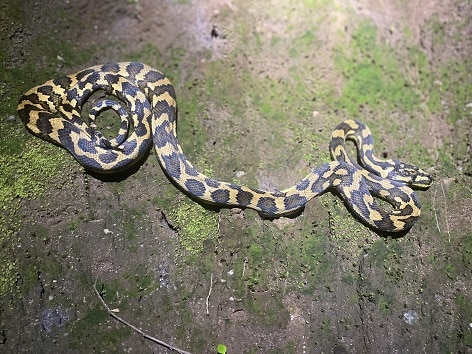
Diamond python (Morelia spilota spilota) – the “main” carpet python, residing in southeast coastal Australia, including Sydney. Tends to be blacker than those further north. A particularly docile subspecies.
McDowell’s carpet python (M. s. mcdowelli) – the eastern coastal version further north, which begins where M. s. spilota ends, covering Queensland and New South Wales, including Brisbane. The largest subspecies, regularly reaching 3 metres.
M. s. metacalfei – the eastern outback version. Avoids the coasts, and has a large range in the arid wastelands of central Australia.
Jungle carpet python (M. s. cheynei) – a subspecies of extremes. This is the most prone to bite, has the smallest range (northeast Queensland), and has the most vividly contrasting black and yellow colours.
Centralian carpet python (M. s. bredli) – lives in scorched central Australia. Has redder tinges to blend with the red soil. Possible a separate species.
Morelia imbricata – the southwest Australian version. Once a subspecies, now a different species. However, its colours are very similar. Also found offshore on islands such as Garden Island.
Darwin carpet python (M. s. variegata) – the main far northern version, occupying a large chunk of Northern Territory, plus western Australia. Smaller, rarely exceeding 2.5 metres.
